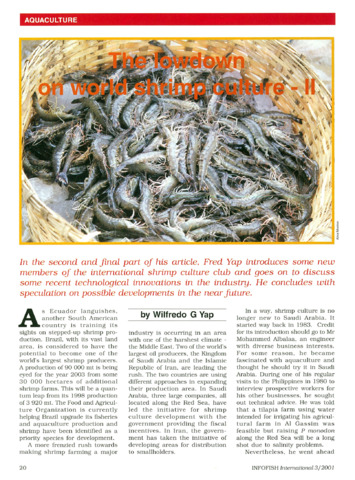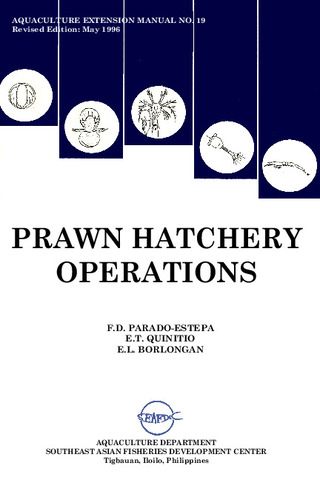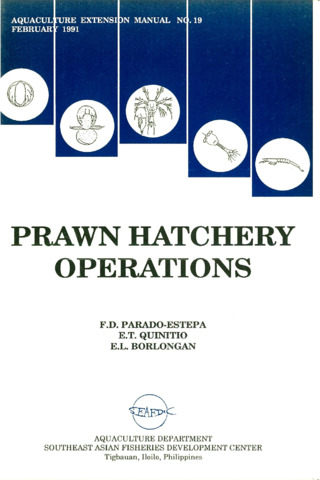| dc.contributor.author | Baliao, Dan D. | |
| dc.contributor.author | de los Santos, Miguel A. | |
| dc.date.accessioned | 2012-06-13T11:40:50Z | |
| dc.date.available | 2012-06-13T11:40:50Z | |
| dc.date.issued | 2011 | |
| dc.identifier.citation | Baliao, D.D. & de los Santos, M.A. (2011). Low or partial discharge and closed-recirculating systems for the culture of shrimp [Penaeus monodon (Fabricius)] at several demonstration sites in the Philippines. The Philippine Agricultural Scientist 94(2), 187-194. | en |
| dc.identifier.issn | 0031-7454 | |
| dc.identifier.uri | http://hdl.handle.net/10862/984 | |
| dc.description.abstract | A series of verification runs on the farming of shrimp [Penaeus monodon (Fabricius)] using environment-friendly techniques was conducted in different pilot demonstration sites including privately owned farms in the Philippines from 2001 to 2005. Encouraging results were achieved using the low or partial discharge and closed-recirculating systems following the advanced environment-friendly protocols. In the low or partial discharge system, 11 grow-out ponds were stocked with P. monodon post larvae (PL) at densities between 15 and 25 m-2 while in the closedrecirculating system, eight grow-out ponds were stocked with PLs at densities between 30 and 60 m-2. Both systems incorporated the use of head and tail reservoirs, crop rotation, filter box, salinity reduction, long-arm paddlewheel aerators, biomanipulators, biofilters, sludge collectors and quality feeds.
In the low or partial discharge system, an average total yield of 5.3 ± 0.8 tons ha-1, a feed conversion ratio (FCR) of 1.4 ± 0.3 and a survival rate of 86 ± 12 % were achieved after 109–159 d of culture (DOC). In a closed recirculating system, however, an average total yield of 8.3 ± 4.0 tons ha-1, FCR of 1.9 ± 0.2 and survival rate of 76 ± 15 % were achieved after 126–150 DOC.
Analyses of effluents from grow-out ponds revealed that treatment using the tail reservoir with installed baffles and oysters (Crossostrea sp.) and seaweed (Gracilaria sp.) used as biofilters effectively reduced the dissolved organic nutrient concentration to optimum levels before the water was recycled or released to the surrounding body of water. Shrimps were observed to be growing and feeding normally, with no signs of bioluminescence at night, and no sluggish swimming behavior. | en |
| dc.language.iso | en | en |
| dc.publisher | College of Agriculture, University of the Philippines Los Baños | en |
| dc.subject | Crassostrea | en |
| dc.subject | Gracilaria | en |
| dc.subject | Penaeus monodon | en |
| dc.subject | Philippines | en |
| dc.title | Low or partial discharge and closed-recirculating systems for the culture of shrimp [Penaeus monodon (Fabricius)] at several demonstration sites in the Philippines | en |
| dc.type | Article | en |
| dc.date.updated | 2012-06-13T06:26:30Z | |
| dc.citation.volume | 94 | |
| dc.citation.issue | 2 | |
| dc.citation.spage | 187 | |
| dc.citation.epage | 194 | |
| dc.citation.journalTitle | The Philippine Agricultural Scientist | en |
| dc.subject.asfa | aquaculture effluents | en |
| dc.subject.asfa | biofilters | en |
| dc.subject.asfa | culture effects | en |
| dc.subject.asfa | feed efficiency | en |
| dc.subject.asfa | feed conversion efficiency | en |
| dc.subject.asfa | pond culture | en |
| dc.subject.asfa | recirculating aquaculture systems | en |
| dc.subject.asfa | seaweeds | en |
| dc.subject.asfa | shrimp culture | en |
| dc.subject.asfa | survival | en |
| dc.subject.asfa | yields | en |
| dc.subject.scientificName | Penaeus monodon | en |



